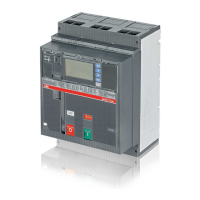3.6.5.2. (Directional) zone selectivity D
The Directional Zone Selectivity (SdZ D) function is particularly useful in ring and grid type systems where, in addition to the zone,
it is essential to define the direction of the power flow that powers the fault.
SdZ D can be enabled as an alternative to Zone Selectivity S and G (which must be disabled in order to obtain correct operation)
and needs Vaux.
For the purpose of establishing the zone and power flow, each protection release has two inputs (DFin and DBin) and two outputs
(Dfout and DBout), which must be connected to the other releases (see example below).
Similarly to SdZ S and G, the releases interact with each other by sending cut-out signals via the outputs and reading them via
the inputs.
The general behavior is summarized in the table below.
(Example with power flow setting “Top → Bottom”).
Ifault (I
f
) Output status Input status T trip
Value Direction DFout DBout DFin DBin
I
f
< I
7
either 0 0 either either No trip
I
f
> I
7
Top → Bottom 1 0 0 either t
s
I
f
> I
7
Top → Bottom 1 0 1 either t
7FW
I
f
> I
7
Bottom → Top 0 1 either 1 t
7BW
I
f
> I
7
Bottom → Top 0 1 either 0 t
s
Output DFout is activated (1) if the power flow is concordant with the direction set in the protection release.
Vice versa, if the power flow is out of phase, the output DBout is enabled (1).
The typical configuration of the system of circuit-breakers for which the SdZ D is likely to be used is the sort of ring illustrated in
the following figure.
If a fault is detected (I fault If beyond the threshold I7) in one of the sections of the system (Load A), the final circuit-breakers for the
section in question (Release1 and Release2) communicate the presence of the fault to the connected circuit-breakers (Release4
and Release3) by setting the output signals DFout or DBout depending on the direction of the current (DFout1=On, DB2out=On).
To be more precise, the circuit-breakers that limit the section affected by the fault see the direction of the fault current in different
ways (Release1=forward and Release2=backward).
The circuit-breakers (Release1 and Release2) delimiting the section affected by the fault are tripped with the selectivity time ts,
while the circuit-breakers further away from the fault count down the time t7FW (Release4) and t7BW (Release3) without opening;
in this way, the system is isolated, in the time ts, to exclude the part affected by the fault.
The load A, where the fault has occurred, will be disconnected, but loads B and C will continue to be powered normally.
It should be noted that activation of the DBout3 output by the Release3 will have no effect on the Release4, because the latter is
recording not an out-of-phase (backward) fault current, but an in-phase (forward) current with the power flow defined previously
by the user (Top → Bottom).
Notes:
- When zone selectivity is active and the direction of the power cannot be established, the protection release takes effect by
considering the shorter time between t7fw and t7bw, without activating any output (DFout or DBout).
- If, for some reason, one of the circuit-breakers required to open does not do so, a specific function will activate the opening of
the first circuit-breaker immediately upstream from it, after a further 100ms approx. In the above example, if the circuit-breaker
does not open with the Release1, only the circuit-breaker with Release4 will open after a time ts+100ms.
- The SdZ D operates on the basis of the phase currents, not of the neutral.
Release 4
Release 1
Release 3
Release 2
B1751

